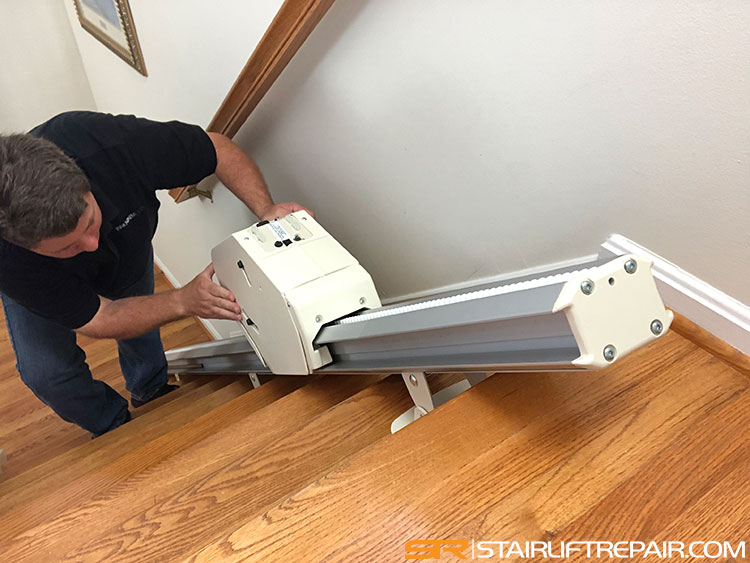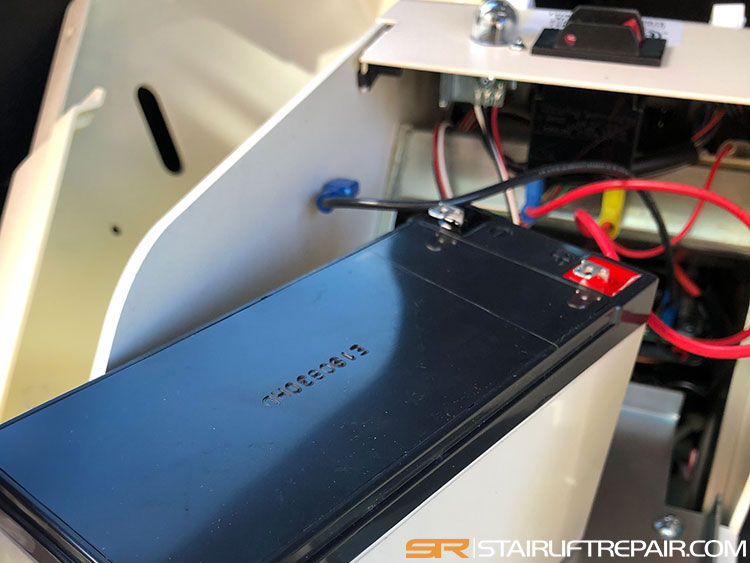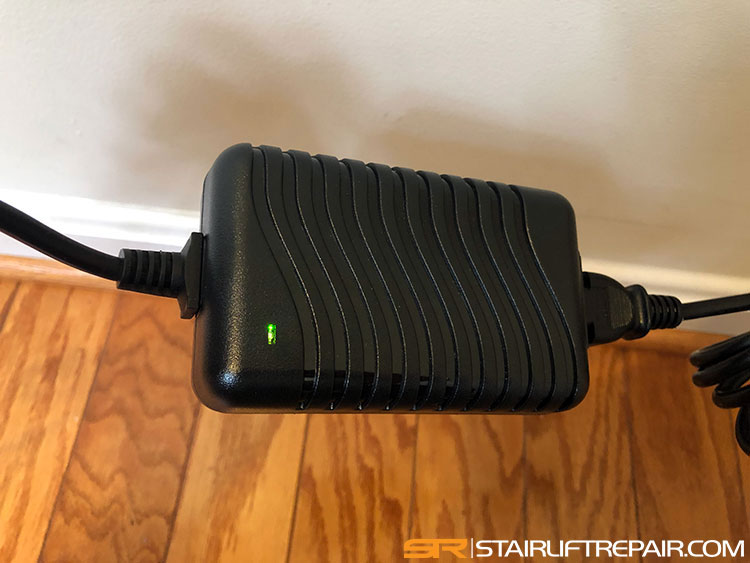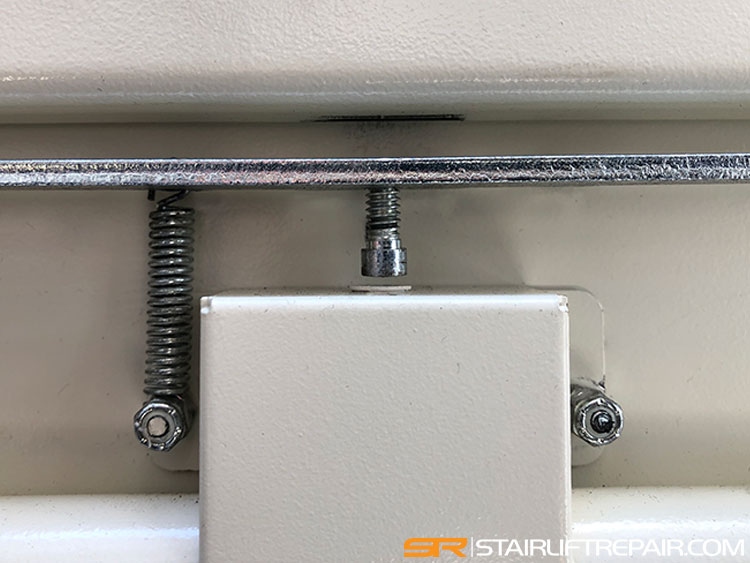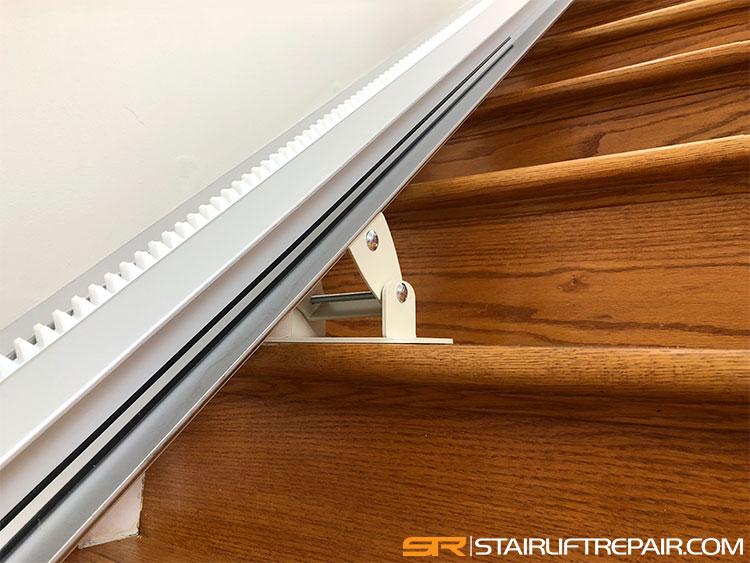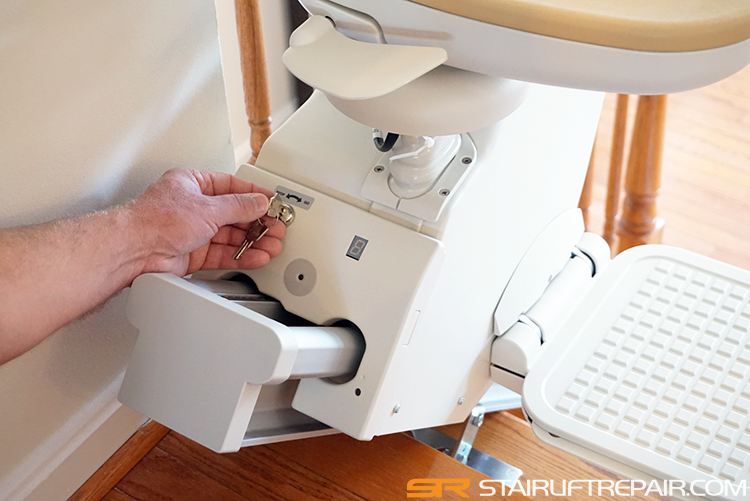The AmeriGlide Rave 2 is a slim-profile, straight-rail stair lift. The aluminum rail mounts to the treads with adjustable brackets, making both installation and later track adjustments straightforward. The lift has a worm gear drive, is battery operated with two onboard 24 V DC batteries that recharge at the top and bottom landings, and a 350 lb. rated capacity.
Components serviced most often.
For the AmeriGlide Rave 2, technicians are called out most often to replace consumable parts, clean the charging system, adjust safety interlocks, track inspection, and change the batteries in the lift. Knowing what each of these components does and the tell-tale symptoms when they start to fail can help you decide whether a quick DIY fix will do the trick or if it’s time to book a professional service visit.
Batteries – Two 12-V sealed AGM.
Plan on changing the main batteries every two to four years. When they’re wearing out you’ll notice the chair stopping part-way up the rail, creeping only a few inches at a time, or beeping while it sits at a charge station. Remember to keep the charger plugged into the wall outlet so the lift can trickle-charge around the clock, the system is designed for a continuous power supply.
Charge contacts and wiring.
After three to five years the metal contacts at the top and bottom landings and the small wiring harness that feeds them start to show wear marks and need to be checked. If the green charge light never comes on or the lift is dead the morning after you used it the contacts are one of the first places to look. A quick polish with fine emery cloth or swapping in a replacement contact kit is usually all that’s needed to restore reliable charging.
Limit and safety switches (armrest, swivel seat, footplate, track-end).
These safeties aren’t changed on a schedule, they’re serviced only when a failure occurs. If the chair refuses to move in either direction, an open safety circuit is the most common cause. Our technicians isolate the faulty switch with a multimeter, but you can often find the problem yourself by making sure the armrests are down, the seat is fully swivel-locked, and the footplate is lowered.
Rollers and gear-rack lubrication.
Although the Rave 2 rail is marketed as “grease-free,” the nylon rollers and rack benefit from a cleaning and light PTFE spray every 12 to 18 months. When lubrication is overdue, the ride turns bumpy and you may hear a clicking as the carriage climbs. A quick clean and re-spray quiets the lift and reduces long-term wear on the drivetrain.
Remote-control batteries.
Expect to pop fresh batteries into the handheld remotes every year or two. When they’re flat, the lift will still run from the carriage-mounted rocker switch but ignore the call-send remotes at the landings. Swapping the batteries is a simple DIY task—no tools or service call required.
| Component | Service | Symptoms | Notes |
|---|---|---|---|
| Batteries (2 × 12 V sealed AGM) | 2-4 years | Lift stops mid-rail, moves only a few inches, or beeps repeatedly at the charge stations | Keep the outlet for the charger on a non-GFCI circuit so it can trickle-charge 24/7 |
| Charge contacts & wiring | 3-5 years | No charge indicator, lift dies overnight | Check the power supply for a green light and that the outlet has power |
| Limit / safety switches (armrest, swivel, footplate, track-end) | On demand | Lift will not move in either direction | Most “won’t run” calls are traced to an open safety circuit |
| Rollers & gear rack lubrication | 12-18 months | Bumpy ride or “clicking” noise | The rail is marketed as grease-free, but a light PTFE spray keeps it quiet |
| Remote-control batteries | 1-2 years | Lift runs from carriage buttons but not remotes | DIY change—no technician needed |
Troubleshooting checklist before you call
Before you pick up the phone run through this quick troubleshooting checklist. Each step takes less than a minute and resolves the majority of “lift won’t move” calls we see with the AmeriGlide Rave 2. By ruling out simple oversights such as an unlocked seat, or a tripped charger outlet, you can often get the chair running again immediately and avoid the cost and downtime of a service visit.
Seat swivel and armrests
The Rave 2 will not move unless the seat is snapped back into its forward-facing position and both armrests are folded down. Each of these parts hides a safety microswitch; if just one remains open, the control board thinks you’re still getting on or off and keeps the motor disabled. Rotate the seat until you hear or feel it click, also make sure the armrests are folded down,
Footplate
Lower the footplate so the weight-sensing pad underneath isn’t engaged. With the plate folded up, the footrest plate can become jammed and interpret this as someone standing on the stairs refusing to move. Once it’s fully down, try the rocker switch again to see if the carriage moves.
Power / charging light
Look at the power supply station for a steady green charge light. No light means the batteries are not being charged up, often because the wall outlet is on a tripped GFCI or the plug has been knocked loose. Restore power, give the batteries a few hours to recover, and then test the lift.
Obstructions on the rail
Walk the length of the track and brush away any socks, pet toys, or grit, dust and pet hair is a common culprit caught in the rack teeth. Even a small object can jam the rollers or trigger the motor’s current monitor, stopping the chair part-way up.
If these five checks don’t get the lift running, the fault is probably inside the control circuitry or carriage drive. Because the Rave 2 lacks an onboard diagnostic display, pinpointing issues beyond these basics usually requires probing with a multimeter jobs that a qualified stair-lift technician should perform.


